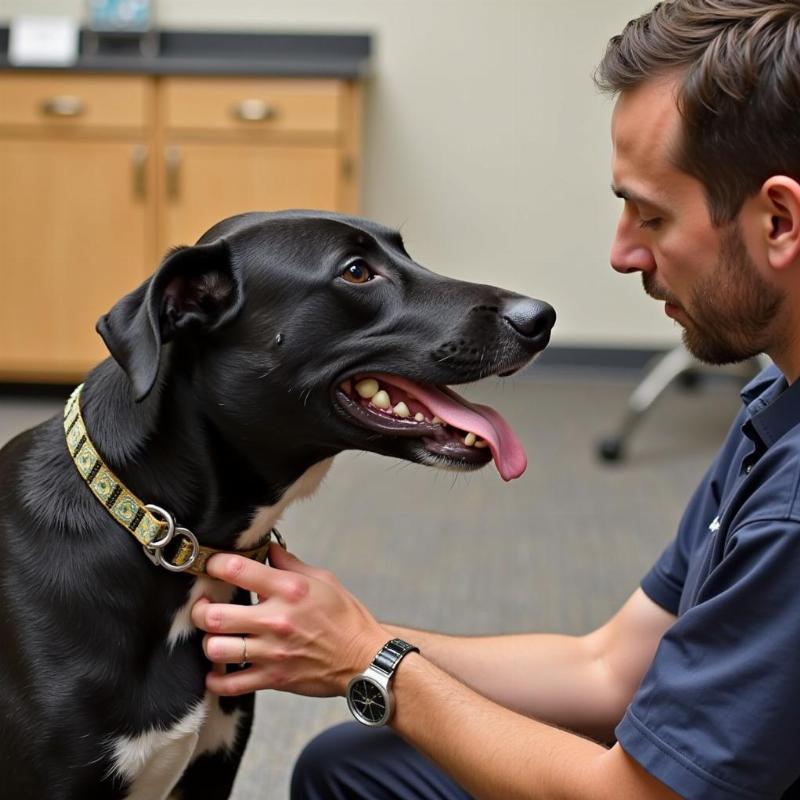Prong dog collars for sale are readily available, but understanding their proper use and potential risks is crucial before making a purchase. This guide will provide you with all the necessary information to make an informed decision about whether a prong collar is right for your dog, and if so, how to use it safely and effectively.
Understanding Prong Dog Collars
Prong collars, also known as pinch collars, are training tools designed to provide immediate and clear corrections to a dog’s pulling behavior. They consist of a series of interlocking metal links with blunted prongs that rest against the dog’s neck. When the dog pulls, the prongs tighten, creating a pressure sensation that discourages the unwanted behavior. It’s important to note that prong collars are not intended to inflict pain, but rather to mimic the sensation a mother dog would use to correct her puppies. However, improper use can lead to discomfort and potential harm.
Are Prong Collars Right for Your Dog?
Prong collars are not suitable for all dogs. Puppies under six months, small breeds, and dogs with neck injuries or tracheal issues should never wear a prong collar. For larger, strong breeds who persistently pull despite training with other methods, a prong collar might be considered, but only under the guidance of a certified professional dog trainer. A trainer can assess your dog’s temperament and ensure the collar is fitted and used correctly. It’s vital to prioritize your dog’s well-being and avoid using a prong collar as a quick fix without professional guidance.
 Dog trainer fitting a prong collar on a dog
Dog trainer fitting a prong collar on a dog
Using a Prong Collar Safely and Effectively
If you decide to use a prong collar under the guidance of a trainer, correct usage is paramount. The collar should sit high on the dog’s neck, just behind the ears, and fit snugly without being too tight. Corrections should be short and sharp, followed by immediate release. Consistency and positive reinforcement are crucial for successful training. The goal is to phase out the prong collar as soon as possible, transitioning to a regular flat collar once the dog understands the desired behavior.
Alternatives to Prong Collars
Many effective and humane alternatives to prong collars exist. Harnesses, such as front-clip harnesses, can redirect pulling pressure and discourage pulling without causing discomfort. Head halters provide gentle control over the dog’s head, allowing you to guide their direction. Positive reinforcement training methods, using treats and praise, are highly effective and build a strong bond between you and your dog. Exploring these options before resorting to a prong collar is always recommended.
Finding Prong Dog Collars for Sale
When searching for prong dog collars for sale, choose a reputable pet supply store or online retailer. Ensure the collar is made of high-quality materials, with blunted prongs to prevent injury. The correct size is essential for proper fit and effectiveness. Consulting with a professional dog trainer before purchasing can help you select the appropriate collar for your dog’s size and breed. Remember, responsible pet ownership involves making informed decisions about training tools and prioritizing your dog’s well-being.
Conclusion
Prong dog collars for sale require careful consideration. While they can be effective tools for managing pulling behavior in certain dogs, proper use and professional guidance are essential. Explore alternative training methods and prioritize your dog’s comfort and safety. With the right approach, you can achieve positive training outcomes without resorting to aversive methods.
FAQ
- Are prong collars cruel? When used incorrectly, prong collars can cause discomfort and potential harm. Proper use, under the guidance of a trainer, is crucial to avoid causing pain.
- Can I use a prong collar on a puppy? No, prong collars are not recommended for puppies under six months old.
- What are some alternatives to prong collars? Harnesses, head halters, and positive reinforcement training are effective alternatives.
- Where can I buy a prong collar? Reputable pet supply stores and online retailers sell prong collars.
- Do I need a trainer to use a prong collar? Consulting with a certified professional dog trainer is highly recommended.
- How do I fit a prong collar correctly? The collar should sit high on the dog’s neck, just behind the ears, and fit snugly.
- How long should I use a prong collar? The goal is to phase out the prong collar as soon as the dog understands the desired behavior.
Related Articles
- all natural tick collar for dogs
- best dog collar for husky
- best dog training collar for 2 dogs
- broke coon dogs for sale
About Beautdogs.us
Beautdogs.us is your premier resource for all things dog-related in the US. We provide expert advice on dog breeds, care, and training, along with reviews of the best products and services. Whether you’re a new dog owner or a seasoned pro, Beautdogs.us is your trusted companion on your dog ownership journey. Contact us for personalized advice and support at [email protected] or +1 501-555-7529.